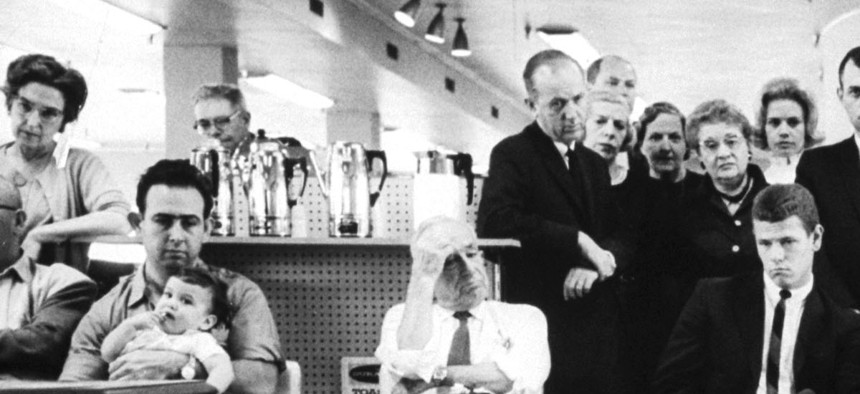
Customers in a California department store watch President Kennedy’s televised address to the nation, as he informs the American people about the unfolding crisis in Cuba, October 22, 1962 Photograph by Ralph Crane Time & Life Pictures/Getty Images
What Do You Get The Guy Who Averts Nuclear War?
New National Archives exhibit displays fun facts and complexities of Cuban Missile Crisis.
How does a president thank the advisers who helped him avert a nuclear war?
With fancy paperweights, of course.
President John F. Kennedy commissioned 34 silver and wood paperweights from Tiffany and Company in the wake of the Cuban Missile Crisis in 1962. The weights depict the calendar month of October, with the 13 days spanning the crisis – Oct. 16 to 28 – embossed in dark black.
One of those celebratory weights is now on display at the National Archives as part of an exhibit that opened last week, "To the Brink: JFK and the Cuban Missile Crisis." It will remain on view until Feb. 3.
Laura Diachenko, a public affairs specialist at the National Archives, said the exhibit featured some never-before-displayed items taken from the John F. Kennedy Presidential Library. These items include personality profiles of Cuban leader Fidel Castro and Soviet Premier Nikita Khrushchev created by the CIA.
The display includes secret White House recordings made at the height of the crisis, including tense discussions between Kennedy and the executive committee of the National Security Council, whose members can be heard debating the cost of nuclear war.
Stacey Bredhoff, curator at the Kennedy Library, helped assemble the exhibit. She said the taped conversations were some of the most interesting pieces.
“As the discussions progress, it’s really kind of a race against the clock, because minute by minute these missile sites are getting closer to being fully operational,” Bredhoff said. “I think you get a sense of that building tension.”
The conversations reveal the technological hurdles Kennedy and Khrushchev had to overcome when negotiating and how miscommunications brought both countries to the brink of nuclear war.
“The exhibit shows that, even though there were negotiations between President Kennedy and Premier Khrushchev, the events are beginning to slip even out of their control,” Bredhoff said.
Ray Hanson, 65, toured the display on opening day. A retired writer from the Department of the Army in Huntsville, Ala., Hanson was 15 during the Cuban Missile Crisis. He said the taped conversations among staff members were the most interesting part of the exhibit for him.
"I just enjoy hearing it as it happened," Hanson said. "I think it was probably the first time I'd heard it. Maybe bits before, but not to the extent that I heard it in there."
Hanson's friend Mike Stringfellow, 60, who is a writer at the Department of the Army in Huntsville, said the exhibit helped him see the complexity of the crisis.
"It wasn't simply a series of incidents," Stringfellow said. "It was very complicated negotiations between Kennedy and Khrushchev. It was very delicate, very complicated."
Stringfellow was 10 years old in October 1962 and only vaguely remembers people talking about the crisis.
"I was more interested in my bicycle than in nuclear war," he said.
Stringfellow does remember the duck-and-cover drills that U.S. schools often practiced at the height of the Cold War, when schoolchildren would be instructed by their teachers to hide under their desks for protection.
"Even then, it didn't seem to me that this tiny wooden desk would provide much cover to our safety," Stringfellow said. "It was kind of strange."
Bredhoff visited the exhibit on opening day to see how visitors would respond.
“What people are saying is that, ‘It really got my heart racing faster,’ or ‘I felt a knot in my stomach,’” Bredhoff said. “They are really getting a sense not just intellectually, but emotionally about how close we actually came to utter destruction.”
The Cuban Missile Crisis ended when Khrushchev agreed to disassemble the missile bases in Cuba if the U.S. promised not to invade Cuba and secretly removed missile bases in Turkey. The crisis also sped the development of the Limited Nuclear Test Ban Treaty, which was signed by the U.S. and the Soviet Union in 1963. The original signed treaty is also on display.
Nearly 900 people toured "To the Brink: JFK and the Cuban Missile Crisis," on its first day, Diachenko said.
Do you remember the days during the Cuban Missile Crisis?






